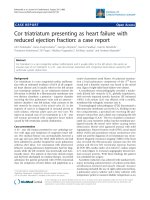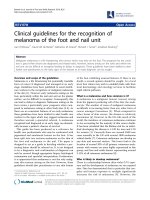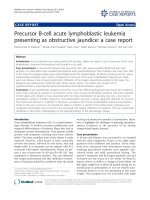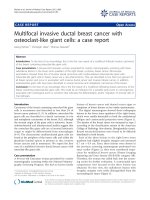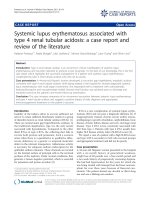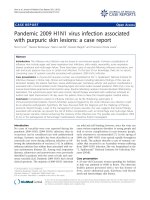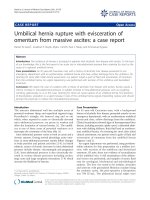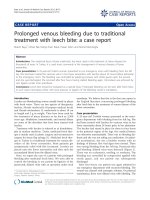Báo cáo y học: " Management options for accidental injection of epinephrine from an autoinjector: a case report" doc
Bạn đang xem bản rút gọn của tài liệu. Xem và tải ngay bản đầy đủ của tài liệu tại đây (257.89 KB, 3 trang )
Case report
Open Access
Management options for accidental injection of epinephrine from
an autoinjector: a case report
Christian Mathez, Bernard Favrat and Philippe Staeger*
Address: Department of Ambulatory Care and Community Medicine, University of Lausanne, Bugnon 44, 1011 Lausanne-CHUV, Switzerland
Email: CM - ; BF - ; PS* -
* Corresponding author
Received: 6 February 2008 Accepted: 30 March 2009 Published: 8 June 2009
Journal of Medical Case Reports 2009, 3:7268 doi: 10.4076/1752-1947-3-7268
This article is available from: />© 2009 Mathez et al; licensee Cases Network Ltd.
This is an Open Access article distributed under the terms of the Creative Commons Attribution License (
/>which permits unrestricted use, distribution, and reproduction in any medium, provided the original work is properly cited.
Abstract
Introduction: Epinephrine autoinjector devices are used with increasing frequency to treat severe
anaphylactic reactions. Accidental injection, usually involving a finger, is a potential complication.
Case presentation: A physician in a Family Practice training program accidentally injected
epinephrine into his left thumb while reading the operating instructions of an autoinjector (Epipen
®
).
He developed swelling, pallor, and pain in the thumb. Treatment included topical nitroglycerin, oral
vasodilators and warming of the thumb. As expected, none caused an immediate response; however,
after 8 hours, the thumb was pink and warm. There was full recovery 2 months after the accident.
We reviewed the treatment of accidental epinephrine injection, and found that the use of parenteral
adrenergic alpha blocker phentolamine would have produced immediate recovery.
Conclusions: All health professionals concerned with the use of epinephrine autoinjectors should
receive adequate instruction on their use. A regimen for management of accidental epinephrine
injection, in particular the use of phentolamine, should be emphasized.
Introduction
Treatment of severe anaphylaxis with epinephrine auto-
injector devices such as Epipen® (or Anapen®) and Epipen
Jr® has been available since 1980. Patients who have an
acute allergic reaction can immediately inject epinephrine
with them, reversing peripheral vasodilation, edema,
constriction of the airways, and myocardial depression.
However, these devices are not without risk: myocardial
infarction from injected epinephrine has been reported
[1]. We report a physician who accidentally injected
epinephrine into his thumb while handling an autoinjec-
tor, and the results of reviewing the literature.
Case presentation
A 31-year-old physician in a Family Practice training
program at an academic primary care center was handling
an Epipen® because he wanted to be familiar with it before
prescribing it. While reading the operating instructions, he
attempted to launch the needle but erroneously placed
his left thumb over the needle opening. He accidentally
discharged the contents of the spring-loaded syringe into
his thumb; and the needle was twisted into the distal tip of
his finger. Hand X-ray did not show a fracture of the distal
phalanx. He complained of pain and paresthesia in the
thumb. The entire digit was cool and pale, and a
Page 1 of 3
(page number not for citation purposes)
prolonged capillary refill time was seen at more than 10 s
(Figure 1). His blood pressure was 175/85 mmHg, heart
rate 80/minute, and respiratory rate 16/minute.
Vascular surgeons, anesthetists, and a hand specialist were
contacted by the treating general internist. Several
approaches were proposed: metacarpal nerve block or
digital block with local lidocaine to induce an inhibition
of sympathetic afferents to the digit; and topical nitrogly-
cerin, systemic vasodilators, and warming by immersion
in water to increase the blood flow supplying the digit.
Topical nitroglycerin, oral vasodilators, and immersion in
warm water were attempted unsuccessfully. The intrave-
nous alpha-blocker phentolamine was not prescribed.
After 8 hours, the entire finger was pink and warm, either
because of the decreasing effect of epinephrine after
90 minutes [2], or because of the delayed effect of the
attempted treatment. Full recovery was noted at a 2-month
follow-up exam.
Discussion
The rate of accidental injection of epinephrine from
autoinjectors has increased worldwide. The incidence is
about 1 per 50,000 Epipen® units [3]. Up to 16% of tested
doctors who read the instructions on the Epipen® device
self-injected the Epipen® trainer into their thumb.
Although no case of digital loss because of an accidental
injection of epinephrine has been reported [4], the risk of
severe pain and even necrosis due to severe local
vasoconstriction is real, so developing formal treatment
[5] guidelines is paramount. Immersion in warm water,
application of topical nitroglycerin, and nerve blockade
have been attempted without success, although Kaspersen
et al. report some recovery [6]. Subcutaneous injection
of terbutaline to reverse vasospasm has been reported
once [7].
Since epinephrine induces a vasoconstriction through an
alpha adrenergic effect, the use of phentolamine seems
logical. Phentolamine is used to control blood pressure
during surgery for pheochromocytoma and paragan-
glioma, when the tumor releases catecholamines because
of manipulation and the stress of surgery. Its use is limited
by adverse side effects such as hypotension and tachycar-
dia, requiring adequate pre-hydration. Zucker first
described phentolamine as useful to prevent necrosis
due to levarter enol [8] and Jordan first showed the
effectiveness of this drug for accidental epinephrine
injection [9]. Others have used local infiltration of
accidental epinephrine injection sites successfully [10-14].
We think a regimen of treatment should be available to
treat accidental epinephrine injection. Velissariou et al.
[14] successfully used 1.5 mg of phentolamine (from a
10 mg/ml phentolamine mesylate ampoule) diluted in
1 ml of 2% lidocaine to treat such accidents. Velissariou
et al. injected “[this mixture] subcutaneously into the site [of
accidental epinephrine injection,] and stop as soon as the skin
becomes pink”. Peripheral perfusion is restored usually in
less than 5 minutes.
Formal training should be provided to all health profes-
sionals who prescribe or issue epinephrine autoinjectors.
Implicit in epinephrine autoinjector prescriptions is that
physicians and pharmacists are confident that the patient
or a relative can adequately use the device, and that the
patient is aware of the potential dangers of incorrect
administration. Thus, those receiving prescriptions for
epinephrine autoinjectors should receive similar training.
A regimen of management of accidental epinephrine
injection emphasizing the use of phentolamine should
be instigated.
This event also highlights the importance for all doctors to
gain quick access to information in the case of unusual
presentation. Access to medical databases through new
technologies is essential.
Figure 1. Delayed capillary refill of the left thumb after
accidental injection of epinephrine.
Page 2 of 3
(page number not for citation purposes)
Journal of Medical Case Reports 2009, 3:7268 />Consent
Written informed consent was obtained from the patient
for publication of this case report and any accompanying
images, but is obvious as the patient is the first author of
this case report. A copy of the written consent is available
for review by the Editor-in-Chief of this journal.
Competing interests
The authors declare that they have no competing interests.
Authors’ contributions
CM, PS and BF have made substantial contributions to
conception, design, writing the manuscript and literature
review. All authors read and approved the final
manuscript.
Acknowledgements
Alain Pécoud is thanked for c ritically r eviewing the
manuscript.
References
1. Saff R, Nahhas A, Fink JN: Myocardial infarction induced by
coronary vasospasm after self-administration of epinephrine.
Ann Allergy 1993, 70:396-398.
2. Greene AK: Management of epinephrine injection injury to the
digit. Plast Reconstr Surg 2005, 115:1800-1801.
3. McGovern SJ: Treatment of accidental digital injection of
adrenaline from an auto-injector device. J Accid Emerg Med
1997, 14:379-380.
4. Fitzcharles-Bowe C, Denkler K, Lalonde D: Finger injection with
high-dose (1:1,000) epinephrine: does it cause finger necrosis
and should it be treated? Hand 2007, 2:5-11.
5. Mehr S, Robinson M, Tang M: Doctor - how do I use my EpiPen?
Pediatr Allergy Immunol 2007, 18:448-452.
6. Kaspersen J, Vedsted P: [Accidental injection of adrenaline in a
finger with EpiPen]. Ugeskr Laeger 1998, 160:6531-6532.
7. Stier PA, Bogner MP, Webster K, Leikin JB, Burda A: Use of
subcutaneous terbutaline to reverse peripheral ischemia. Am J
Emerg Med 1999, 17:91-94.
8. Zucker G: Use of phentolamine to prevent necrosis due to
levarterenol. J Am Med Assoc 1957, 163:1477-1479.
9. Denkler K: A comprehensive review of epinephrine in the
finger: to do or not to do. Plast Reconstr Surg 2001, 108:114-124.
10. Burkhart KK: The reversal of the ischemic effects of epinephr-
ine on a finger with local injections of phentolamine. J Emerg
Med 1992, 10:496.
11. Hinterberger JW, Kintzi HE: Phentolamine reversal of epinephr-
ine-induced digital vasospasm. How to save an ischemic
finger. Arch Fam Med 1994, 3:193-195.
12. Maguire WM, Reisdorff EJ, Smith D, Wiegenstein JG: Epinephrine-
induced vasospasm reversed by phentolamine digital block.
Am J Emerg Med 1990, 8:46-47.
13. Sellens C, Morrison L: Accidental injection of epinephrine by a
child: a unique approach to treatment. CJEM 1999, 1:34-36.
14. Velissariou I, Cottrell S, Berry K, Wilson B: Management of
adrenaline (epinephrine) induced digital ischaemia in chil-
dren after accidental injection from an EpiPen. Emerg Med J
2004, 21:387-388.
Page 3 of 3
(page number not for citation purposes)
Journal of Medical Case Reports 2009, 3:7268 />Do you have a case to share?
Submit your case report today
• Rapid peer review
• Fast publication
• PubMed indexing
• Inclusion in Cases Database
Any patient, any case, can teach us
something
www.casesnetwork.com


